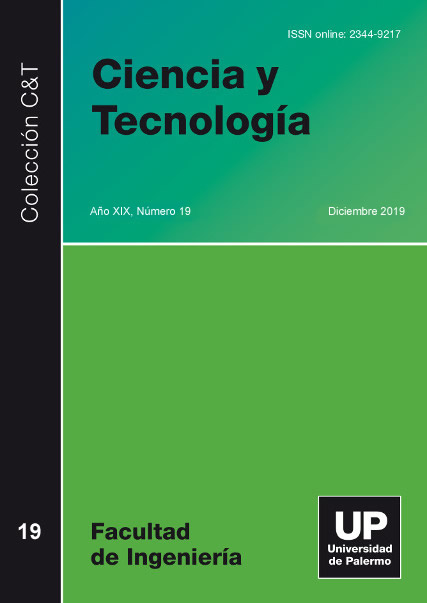Análisis Estadístico de Algoritmos Evolutivos para el problema de Selección de Variables
Abstract
Decades of research in optimization problems have generated a considerable number of algorithms, both deterministic and heuristic. However, due to this wide range of possibilities, determine which one is the most appropriate for a specific problem is a complex task. In this paper, a comparison among different heuristic optimization algorithms using statistical test is proposed. Simulated Annealing (SA), Simple Genetic Algorithm (sGA), Genetic Algorithms Compact (cGA) and Deterministic Crowding (DC) were used, applied to the Variable Selection for estimation problem using Linear Regression. Three test cases were used: solar radiation at the province of Tucuman (Argentina), power consumption estimation in the same area, and estimation of the reappearance of cancer cells. We concluded that there is sufficient statistical evidence to affirm that the algorithms yield significantly different results. Also, we concluded that sGA and DC were the most suitable algorithms, obtaining similar fitness values, being sGA slightly better.
Downloads
References
Ahn, C. W., & Ramakrishna, R. S. (2003). Elitism-based compact genetic algorithms. Evolutionary Computation, IEEE Transactions on, 7(4), 367-385. https://doi.org/10.1109/TEVC.2003.814633
Coffin, M., & Saltzman, M. J. (2000). Statistical analysis of computational tests of algorithms and heuristics. INFORMS Journal on Computing, 12(1), 24–44. https://doi.org/10.1287/ijoc.12.1.24.11899
De Jong, K. A. (1975). Analysis of the behavior of a class of genetic adaptive systems (PhD Thesis). University of Michigan.
Denardo, E. V. (2012). Dynamic programming: models and applications. Courier Corporation.
Derrac, J., García, S., Molina, D., & Herrera, F. (2011). A practical tutorial on the use of nonparametric statistical tests as a methodology for comparing evolutionary and swarm intelligence algorithms. Swarm and Evolutionary Computation, 1(1), 3-18. https://doi.org/10.1016/j.swevo.2011.02.002
Eldén, L. (2007). Matrix Methods in Data Mining and Pattern Recognition. Philadelphia, PA, USA: Society for Industrial and Applied Mathematics.
Harik, G. R., Lobo, F. G., & Goldberg, D. E. (1999). The compact genetic algorithm. Evolutionary Computation, IEEE Transactions on, 3(4), 287–297. https://doi.org/10.1109/4235.797971
Hauschild, M., & Pelikan, M. (2011). An introduction and survey of estimation of distribution algorithms. Swarm and evolutionary computation, 1(3), 111–128. https://doi.org/10.1016/j.swevo.2011.08.003
Jimenez, V. A., Lizondo, D., Will, A., & Rodriguez, S. (2017). Short-Term Load Forecasting for Low Voltage Distribution Lines in Tucumán, Argentina. 5to Congreso Nacional de Ingeniería Informática / Sistemas de Información (CoNaIISI 2017), 940-949. Santa Fe, Argentina.
Kirkpatrick, S. (1984). Optimization by simulated annealing: Quantitative studies. Journal of statistical physics, 34(5-6), 975–986. https://doi.org/10.1007/BF01009452
Kotu, V., & Deshpande, B. (2015). Chapter 12 - Feature Selection. En V. Kotu & B. Deshpande (Eds.), Predictive Analytics and Data Mining (pp. 347-370). https://doi.org/10.1016/B978-0-12-801460-8.00012-4
Mahfoud, S. W. (1995). Niching methods for genetic algorithms. Urbana, 51(95001), 62–94.
Parsopoulos, K. E. (2010). Particle swarm optimization and intelligence: advances and applications: advances and applications. IGI global.
Peng, X., Bessho, M., Koshizuka, N., & Sakamura, K. (2014). A framework for peak electricity demand control utilizing constraint programing method in smart building. 2014 IEEE 3rd Global Conference on Consumer Electronics (GCCE), 744–748. https://doi.org/10.1109/GCCE.2014.7031211
Talbi, E.-G. (2009). Metaheuristics: from design to implementation (Vol. 74). John Wiley & Sons.
Varmuza, K., & Filzmoser, P. (2008). Introduction to multivariate statistical analysis in chemometrics. CRC press.
Will, A., Bustos, J., Bocco, M., Gotay, J., & Lamelas, C. (2013). On the use of niching genetic algorithms for variable selection in solar radiation estimation. Renewable Energy, 50, 168–176. https://doi.org/10.1016/j.renene.2012.06.039
William H. Wolberg, O. L. M. (1992). Wisconsin Breast Cancer Database [https://archive.ics.uci.edu/ml/datasets/Breast+Cancer+Wisconsin+ (Prognostic)].
Williams, M., & Daneshyari, M. D. (2016). Clonal vs. Negative Selection in Artificial Immune Systems (AIS).
Yu, X., & Gen, M. (2010). Introduction to Evolutionary Algorithms. En Decision Engineering. Springer.
The articles published in the journal Ciencia y Tecnología are the exclusive property of their authors. Their opinions and content belong to their authors, and the Universidad de Palermo declines all responsibility for the rights that may arise from reading and/or interpreting the content of the published articles.
The reproduction, use or exploitation by any third party of the published articles is not authorized. Its use is only authorized for exclusively academic and/or research purposes.









